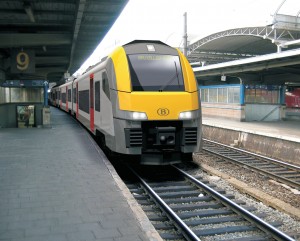New Trains in Brussels Make Commuting More Attractive
Posted: 8 June 2010 | | No comments yet
Brussels, the “European City of Congestion” is currently making efforts to reduce its urban car traffic…
Brussels, the "European City of Congestion" is currently making efforts to reduce its urban car traffic...


Desiro ML AM08 by Siemens Mobility.
Brussels, the “European City of Congestion” is currently making efforts to reduce its urban car traffic. From 2011, Belgian State Railways will put 305 new three-car electric trains in service for regional traffic in the Belgian capital. The background for this fleet upgrade is an initiative to make Brussels’s Light-Rail-Vehicle system more attractive for commuters. For the trains of the AM08 series of the Desiro ML of Siemens Mobility, Voith Turbo Scharfenberg will deliver 1 220 semi-permanent and 610 automatic couplers. The first units have already left the Voith plant in Salzgitter.
Every day, some 365 000 commuters are on the move in the Brussels metropolitan region and constitute a vast potential for public transport. At present, the Brussels transport operator STIB runs a route network spanning over 600 kilometers – comparable with Lisbon (660 kilometers) and eight times as long as the rail network of Atlanta (80 kilometers). But many potential rail passengers in the Belgian capital still rather use their cars and put up with endless traffic jams. One reason for this is the low frequency of regional and suburban trains within a distance of 30 kilometers around the city center. 305 new Desiro railcars are meant to make such regional train journeys more attractive and, in combination with a track expansion, allow higher service frequencies. Up to 30 new or reopened stations, two new lines and a new tunnel are being planned. An airport connection to the extended network is scheduled for 2012.
The Desiro ML AM08 will run from 2011 in a new regional network in Brussels: the Réseau Express Régional (RER). The French model of the RER network has already proven itself excellently in Paris. Basing upon this model, eight S-Bahn lines, starting from the Brussels city center, will be built. These regional trains are stopping at all stations and also cover the outer catchment area of the capital. The equipment of the vehicles developed by Siemens Mobility includes a coupler with GF head (Georg Fischer), which is particularly popular in railway systems in Switzerland and Belgium. Its automatic coupler head differs from the Scharfenberg coupler by a simple locking mechanism and a special head profile. Voith Turbo Scharfenberg has optimized the coupler head and developed it further. While the interfaces remain compatible, the components will have modular design in future.
The semi-permanent Voith Turbo Scharfenberg couplers, which are also part of the delivery, will assume a safety function in the Desiro ML AM08 in the event of a crash – a joint development by Voith Turbo and Siemens Mobility. The 305 new vehicles thus comply with the latest crash requirements (per EN 15227) on a Desiro platform and ensure the collision safety of rail carbodies. This prevents the cars from overriding in the event of an accident.
Voith Turbo, the specialist for hydrodynamic drive, coupling and braking systems for road, rail and industrial applications, as well as for ship propulsion systems, is a Group Division of Voith AG.
Voith is setting the standard in the paper, energy, mobility, and service markets. Established on January 1, 1867, Voith is now one of the largest family-owned businesses in Europe, with 39 000 employees, 5.1 billion euro in sales, and over 280 locations worldwide. Voith is an official partner of the initiative “Germany – Land of Ideas”.


